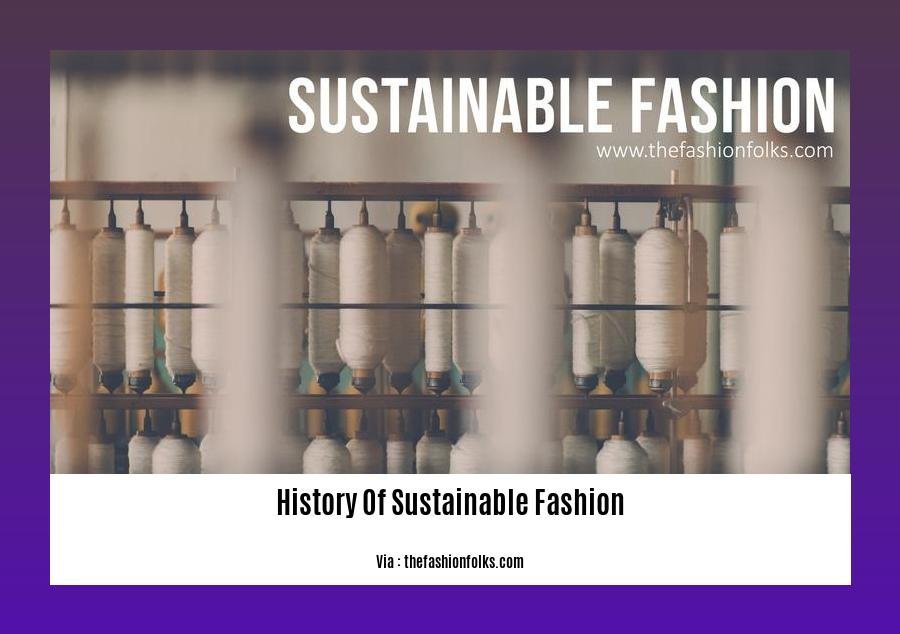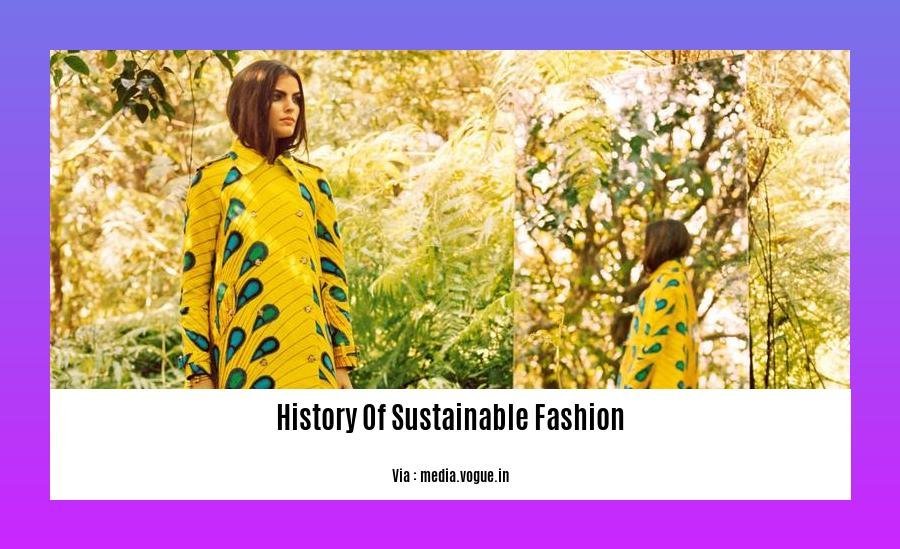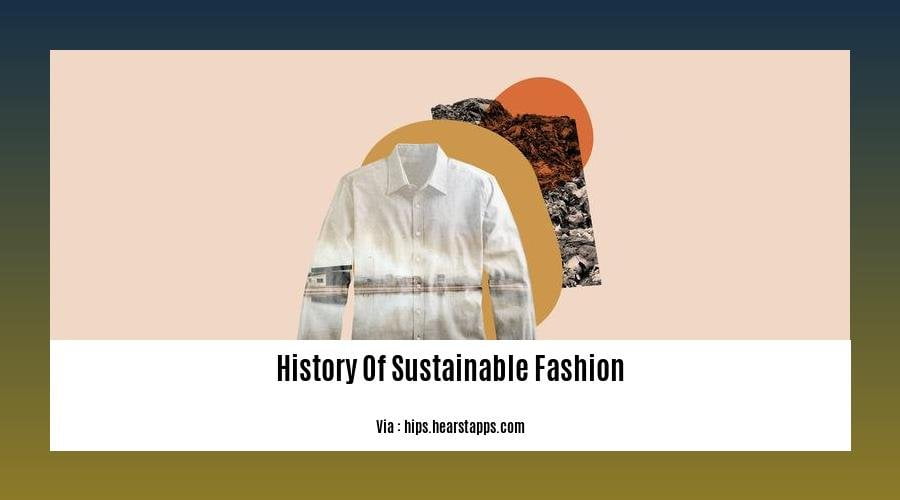Sustainable fashion has emerged from the fringes of counterculture to become a driving force shaping the future of the industry. In this comprehensive exploration, we delve into the rich history of sustainable fashion, tracing its evolution from humble beginnings to its current status as a mainstream movement. Discover how pioneers challenged conventional practices, paving the way for conscious consumerism and ethical production methods. Join us on this journey through time, uncovering the stories of visionary designers, groundbreaking innovations, and the milestones that have redefined the concept of sustainable fashion.
Key Takeaways:
-
The origins of sustainable fashion can be traced back to the late 19th century.
-
The industrial revolution ushered in an era of mass-produced clothing through department stores, contributing to the industry’s environmental impact.
-
In the 1950s and 60s, the countercultural movements embraced vintage clothing and natural fibers as a form of self-expression.
-
The punk rock movement of the 1970s and 80s promoted do-it-yourself fashion and upcycling as a means of individuality and rebellion.
-
The 1990s marked a turning point with heightened awareness for the environment, leading to a significant shift towards sustainable fashion practices.
History of Sustainable Fashion


Sustainable fashion, a term often associated with eco-consciousness and ethical practices, has roots that trace back to the late 19th century. Its evolution is a captivating journey that mirrors the changing values and priorities of society.
Late 19th Century: The Dawn of Eco-Consciousness
The industrial revolution ushered in a new era of mass production and consumption, a period marked by the rise of fast fashion and its environmental consequences. Amidst this, voices emerged advocating for more responsible practices. In the 1890s, Mahatma Gandhi promoted hand-spinning and weaving as a means of economic empowerment and self-sufficiency, emphasizing the need for ethical production.
1950s and 60: A Revolution in Style and Values
The peace and love movement of the 1950s and 60s ignited a countercultural movement that challenged societal norms, including fashion. This era saw a resurgence of vintage clothing and natural fibers like cotton and wool, a reflection of the growing awareness of the environmental impact of synthetic materials.
1970s and 80s: Punk, DIY, and Upcycling
The punk rock subculture of the 1970s and 80s brought forth a wave of DIY fashion and upcycling. Punk rockers expressed their individuality by repurposing and customizing clothing, giving rise to the concept of sustainable style.
1990s: The Rise of Environmental Awareness
The 1990s witnessed a surge in environmental consciousness, which had a profound impact on the fashion industry. Consumers became increasingly aware of the negative environmental consequences of fast fashion, leading to the emergence of sustainable fashion brands that prioritized eco-friendly materials and ethical production practices.
21st Century: Sustainable Fashion Goes Mainstream
In the 21st century, sustainable fashion gained mainstream recognition and acceptance. Fashion weeks around the world began showcasing eco-conscious collections, and major retailers introduced sustainable lines. This shift towards sustainability was driven by growing consumer demand for ethical and eco-friendly products, as well as increased government regulations and industry initiatives.
Today, sustainable fashion is no longer a niche trend but a vital part of the industry, with countless brands embracing circularity, transparency, and ethical practices. The history of sustainable fashion is a testament to the power of collective consciousness and the growing recognition that fashion can be both stylish and sustainable.
Embark on a historical voyage through the history of swordsmanship, tracing its evolution from ancient origins to the modern era of competitive fencing. history of swordsmanship
Journey into the charming world of Sylvanian Families, discovering their rich history and heartwarming stories that have captured the hearts of generations. history of sylvanian families
Step back in time to explore the captivating history of tap dance, from its African roots to its evolution into a vibrant and expressive art form. history of tap dance timeline
History Of Sustainable Fashion Wikipedia
Sustainable fashion, often referred to as eco-fashion, has emerged as a conscious approach to address the environmental and social impacts of the fashion industry. Its roots can be traced back to the late 19th century when concerns about the working conditions in garment factories and the environmental effects of synthetic materials began to surface. However, it wasn’t until the 1960s and 1970s that sustainable fashion gained momentum as part of the broader counterculture movement.
Key Takeaways:
- Sustainable fashion aims to reduce the environmental footprint of the fashion industry, promote social justice, and uphold animal welfare across the supply chain.
- The movement started gaining traction in the 1960s and 1970s as part of the counterculture movement, promoting natural fibers, recycling, and DIY fashion.
- Patagonia, ESPRIT, and Eileen Fisher were among the pioneers of sustainable fashion in the 1980s and 1990s, focusing on organic materials and fair labor practices.
- In the 21st century, sustainable fashion has gained mainstream acceptance, with major brands adopting eco-friendly practices, using recycled materials, and promoting ethical production methods.
- Today, sustainable fashion encompasses a wide range of initiatives, from upcycling and slow fashion to circular economy models and digital innovations, driven by consumer demand for transparency and sustainability.
In the 1980s and 1990s, several pioneering brands, such as Patagonia, ESPRIT, and Eileen Fisher, emerged as advocates for sustainable fashion. They focused on using organic materials, promoting fair labor practices, and reducing their environmental footprint.
The 21st century marked a significant turning point for sustainable fashion as it gained broader acceptance and recognition. Major fashion brands began to adopt eco-friendly practices, incorporate recycled materials, and promote ethical production methods in response to growing consumer demand for transparency and sustainability.
Today, sustainable fashion encompasses a wide range of initiatives, including upcycling, slow fashion, circular economy models, and digital innovations. The industry is constantly evolving, driven by the increasing awareness of the environmental and social impacts of fashion and the growing demand for more sustainable and ethical products.
Sustainable fashion has come a long way from its counterculture roots to becoming a mainstream movement, and it continues to evolve and innovate, shaping the future of the fashion industry.
Bibliography:
[1] https://en.wikipedia.org/wiki/Sustainable_fashion
[2]
FAQ
Q1: When did sustainable fashion emerge?
A1: Sustainable fashion can trace its roots back to the late 19th century, fostered by the rise of industrialization and the subsequent push for mass-produced clothing. However, it wasn’t until the 1990s that environmental concerns gained significant traction within the fashion industry, leading to a shift towards eco-friendly practices.
Q2: What are some key moments in the history of sustainable fashion?
A2: Pivotal moments in the evolution of sustainable fashion include the late 19th century’s focus on mass-produced clothing, the rise of vintage clothing and natural fibers in the 1950s and 60s, the DIY fashion and upcycling movement of the 1970s and 80s, and the surge in environmental awareness that led to the widespread adoption of sustainable fashion practices in the 1990s.
Q3: What are some of the challenges faced by the sustainable fashion industry?
A3: The sustainable fashion industry faces several challenges, including reducing carbon emissions, water usage, and waste generation, addressing social justice issues in the supply chain, ensuring animal welfare, and promoting reuse and recycling through initiatives like reselling, donating, and buying secondhand clothing.
Q4: How is sustainable fashion different from traditional fashion?
A4: Sustainable fashion distinguishes itself from traditional fashion by prioritizing eco-friendly practices and ethical considerations throughout the supply chain. It encompasses a range of strategies, including using sustainable materials, reducing waste, promoting fair labor practices, and minimizing environmental impact.
Q5: What are some examples of sustainable fashion brands?
A5: Prominent examples of sustainable fashion brands include Patagonia, ESPRIT, Stella McCartney, Veja, and Eileen Fisher. These brands have been instrumental in spearheading sustainable initiatives, such as using recycled materials, partnering with ethical suppliers, and promoting transparency in their supply chains.
- Unveiling Bernhard Caesar Einstein’s Scientific Achievements: A Legacy in Engineering - July 15, 2025
- Uncover who is Jerry McSorley: CEO, Family Man, Business Success Story - July 15, 2025
- Discover Bernhard Caesar Einstein’s Scientific Contributions: Unveiling a Legacy Beyond Einstein - July 15, 2025















